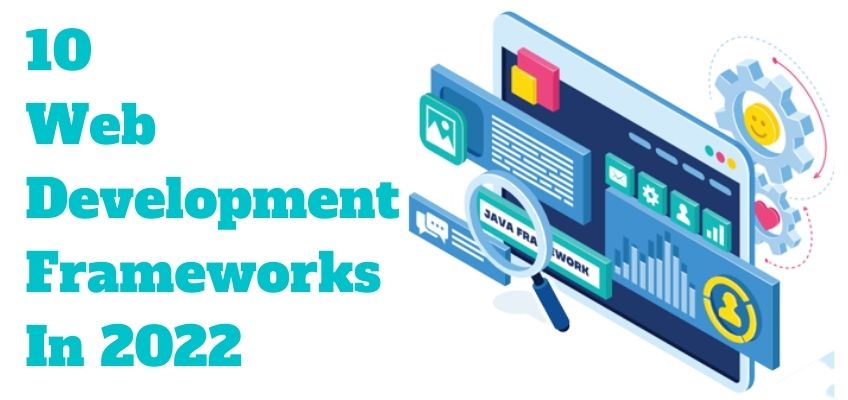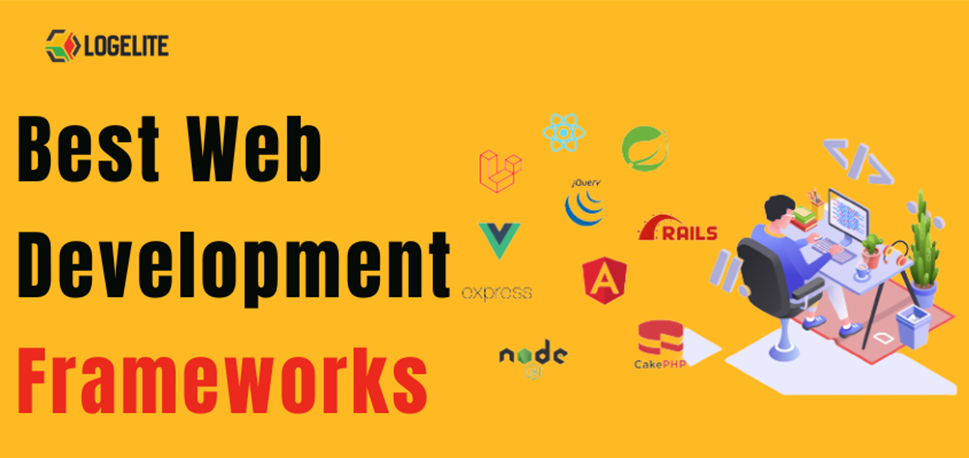Having your website for your business in the digital age has become a must. It can open up the possibility for your enterprise to reach a broader audience base. It attracts business leads even more efficiently. Unlike a few years ago, the extensive need for web app development has led to the inception of many functional frameworks. The frameworks are purposely designed keeping in mind modern business challenges. They offer a simple yet efficient way to develop your web applications.
This blog is dedicated to 10 such productive frameworks for the backend and front end that are highly prevalent. These are known to deliver the best results. This blog also discusses the differences between these types of frameworks and the pros and cons of each framework.
What Is a Web Framework?
A framework is a platform with all the essential ready-to-use programming tools, modules, and libraries used to create software products. Frameworks provide developers with the necessary functionalities and tools and dictate the rules for building the architecture of websites, apps, APIs, services, and other solutions. Hence, you create the skeleton for your project quickly and can further extend it according to your specified requirements.
A framework can also include code libraries, scripting languages, utility programs, and other software. It facilitates the integration and development of various components of a large software project. As a rule, web development platforms are customizable. It means you can take ready-to-use templates and features and tailor them to your specific needs. You may also implement your own code into the platform.
What are the two types of Web Development Frameworks?
Each web application generally includes a client-side part or a front end and a server-side part or a backend. Thus, there are two types of web development frameworks available for both the backend and the front end.
1. Front End Web Development Framework
These frameworks are usually used to design the user interface or the front end of a web application. The front-end frameworks are often based on programming languages such as HTML, JavaScript, and CSS. The role of the front-end framework is to develop the UX/ UI design and deal with other vital aspects of the web app, such as SEO optimization, templates, user interaction management, code snippets, and more.
2. Backend Web Development Framework
These frameworks are used to design the hidden part or the backend of the app that is responsible for the functioning of the web app. Backend frameworks are based on the programming languages such as Ruby, Java, Python, .NET, and PHP. They work by dealing with the database and server functioning, routing protocols, authorization options, data security, solution logic and architecture, and more.
What is the difference between the back end and the front end Frameworks?
- The front end is that part of the web app that interacts with the end-user. In contrast, the backend of a web app refers to the background functioning of the web app.
- The front end offers integrable elements, reusable templates, and pre-written code snippets and manages user interactions. Whereas, The back end provides features such as user authorization, privacy encryptions, database manipulation, and reusable components for connecting the front end to the backend.
- The key features of the front end include UI/ UX designing, SEO optimization, reusable templates, and enhancing the scalability and performance of the app. In contrast, the critical features of the back end include server handling, designing site architecture, database management, security, and URL routing.
- HTML, JavaScript, JQuery, CSS, etc., are a few prominent front-end languages. Python, PHP, Ruby, JavaScript, .NET, etc., are a few prevalent backend languages.
- Vue, Ember, Bootstrap, React, and Angular is the most famous front-end frameworks. Ruby On Rails, Spring, Django, Express, and ASP.NET Core are the most common backend frameworks.
Which are the 10 Best Web Development Frameworks?

The following is the list of 10 best web development frameworks that can be leveraged for web app development:
1. Angular ( Front end )
It is one of the most prominent front-end web development frameworks that many web application development companies leverage. Angular was first introduced in 2008 when it used JavaScript as its programming language. It was later transformed in 2015 and now uses Typescript instead of JavaScript. Angular is known to develop dynamic web pages on the client side.
Angular is an extensive and all-inclusive framework that contains libraries, directives, controllers, and other components, making it difficult to learn compared to other web frameworks. Angular is based on MVC architecture ( Model View Controller ). It can be used to create high-performing single-page apps.
Pros of Angular framework
- Availability of countless Angular js development services
- Two-way data binding is present.
- It supports the MVC architecture.
- It speeds up the app development process.
Cons of Angular framework
- Steep learning curve.
- Slower processing.
- The documentation part is not well-organized.
2. Vue. Js ( Front-end )
Vue is a highly popular web app development framework used to build user interfaces and single-page apps for web apps. The framework is based on MVVM architecture ( Model View ViewModel ). It is lightweight and has numerous features and tools to create functional user interfaces. Vue is simple to learn and use and can be easily integrated with 3 rd party tools and solutions.
Pros of Vue. Js framework
- It has an easy learning curve.
- It is lightweight.
- Easy to integrate with third-party apps.
- The framework aids in swift development.
Cons of Vue. Js framework
- The available tools are not very stable.
- It is not supported by top IT enterprises such as Microsoft, Google, etc.
3. React ( Front-end )
React is a JS library introduced by Facebook ( now Meta ). React acts as a web framework and is mainly used to develop single-page front-end apps. Apart from that, it supports the development of mobile apps, which are usually not supported by most other web frameworks. React integrates with multiple other libraries for successfully conducting state management operations, routing, and interaction with API.
Pros of React
- It consists of a virtual DOM that provides fast manipulation of the documents.
- It supports mobile app development.
- Easy to integrate with other libraries.
Cons of React
- The documentation part is not well organized.
- It has a complicated structure.
4. jQuery ( Front-end )
It is an open-source JavaScript library often used to build app user interfaces. It is known for its simplistic approach and cross-browser compatibility. This framework provides simple interaction between the elements of DOM and its syntax structure. This framework is prominent because of its ability to create amazing animations and effects in the developed apps. It is small and has multiple plugins to add functionalities to its structure easily.
Pros of jQuery
- jQuery offers easy documentation.
- It is effortless to use.
- A robust open-source community backs it.
- It has support for extensive libraries.
Cons of jQuery
- Limited functionalities are included in the framework.
- The jQuery javascript file is needed to make the app function.
5. Ember ( Front-end )
Ember framework has earned the reputation of being the best Javascript framework for app development. It offers many out-of-the-box features that can be used to develop highly functional apps. Ember is used by various tech giants such as Microsoft, Google, and Netflix. It is based on the MVMM architecture and is easy to use. Ember eliminates the need for redundant tasks. It adopts some of the best JS practices in its core design to develop web apps.
Pros of Ember
- The documentation is well-maintained and extensive.
- It supports code debugging.
- It delivers high performance.
Cons of Ember
- It is not suitable for smaller projects.
- The framework has a steep learning curve.
6. Django ( Backend + Frontend )
It is a prominent Python framework with extremely high demand among businesses and developers. This framework uses the concept of code reusability. It follows the MVT ( Model View Template ) Architecture that enables it to develop apps at a faster pace. It is one of the most helpful web frameworks that can be leveraged to create both the backend and front end of the application. The largest corporations, such as Disqus, Instagram, and NASA, use this framework to handle the backend operations. Some of the vital features of this framework are in-built validation, messaging, and authentication. This framework is suitable for designing large and complex business projects.
Pros of Django framework
- Huge community support
- Faster development
- It can create secure and robust apps
- Availability of inbuilt authentication tool
- Well-organized documentation
Cons Of Django
- Slow processing
- Steep learning curve
7. Ruby on Rails ( Backend )
It is one of the oldest web app development frameworks for building an app’s backend. It is based on the Ruby programming language. It has developed over 800,000 websites until now. The framework supports the usage of complex algorithms to build functional logic for complicated business problems. It also includes powerful tools and libraries. It can be used to create cloud-based apps. Apps such as Hulu, GitHub, Airbnb, and Groupon are made using this framework.
Pros of Ruby on Rails framework
- Enormous libraries and tools
- Automation-enabled
- Speedy development
Cons of Ruby on Rails framework
- Improper documentation
- Slow processing
8. Laravel ( Backend )
It is a PHP-based framework that fundamentally works on the paradigms and concepts of PHP scripting language. It works on the MVC ( Model View Controller ) architecture. It comes with API support. It has numerous packages that make this framework extensible and adaptable. This framework is mainly used to develop the backend of web apps. You can hire backend developers proficient in this framework for small to mid-range web solutions.
Pros of Laravel framework
- Good documentation
- Availability of the newest features of PHP
- Integrated mail services
- Cache backends
Cons Of Laravel
- Not suitable for developing mobile apps
- No support for payment gateways
9. Express. JS ( Backend )
It is a Node.js API that is pretty powerful. It can create highly productive web apps. Large enterprises most commonly use it because of its higher flexibility. It has several in-built functionalities and features, such as routing, templating, third-party integrations, server-side scripting, etc., that make it suitable for developing functional apps. In addition, it has a minimalist feel. It is easy to operate if you know the intricacies of this language.
Pros of Express JS framework
- Highly flexible
- Great for API development
- Feature-packed
Cons of Express JS framework
- High learning curve
- Monotonous callbacks
10. Flask ( Backend )
It is a Python-based web framework that is known to build lightweight, robust, and high-performing apps. It is a microframework. It includes all the necessary functions and libraries to create apps from scratch to the ultimate. The key features of this framework are:
- A built-in web server and debugger
- Unit testing support
- WSGI compliance
- RESTful request dispatching
- Unicode support
You can hire a Python programmer fluent in this framework to achieve the best outcomes for your project idea.
Pros of Flask framework
- It is highly flexible.
- Flask is lightweight
- It is scalable
- Good documentation
Cons of Flask framework
- Higher maintenance
- Difficult to use for complex applications
- Availability of limited tools
Conclusion
Web frameworks are highly crucial elements in the software development process. Each of these frameworks has its unique set of advantages and disadvantages. Depending upon your project requirement, each one of them will offer you the best outcome for your project.

Comment
Write a Reply or Comment